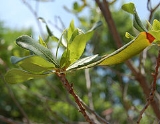
Myrica pensylvanica
Encyclopedia
Myrica pensylvanica, the Northern Bayberry, is a species of Myrica
native to eastern North America
, from Newfoundland west to Ontario
and Ohio
, and south to North Carolina
.
Myrica pensylvanica is a deciduous
shrub
growing to 4.5 m tall. The leaves
are 2.5-7 cm long and 1.5-2.7 cm broad, broadest near the leaf apex, serrate, and sticky with a spicy scent when crushed. The flower
s are borne in catkin
s 3-18 mm long, in range of colors from green to red. The fruit
is a wrinkled berry 3-5.5 mm diameter, with a pale blue-purple waxy coating; they are an important food for Yellow-rumped Warbler
s.
This species has root nodules containing nitrogen-fixing
microorganisms, allowing it to grow in relatively poor soils.
candles. American colonists boiled the berries to extract the sweet-smelling wax, which they used to make clean-burning candles.
Bayberry essential oil, extracted from the aromatic leaves, is used to scent many products. Bayberry essential oil is moderately toxic due to a high eugenol content.
Myrica
Myrica is a genus of about 35–50 species of small trees and shrubs in the family Myricaceae, order Fagales. The genus has a wide distribution, including Africa, Asia, Europe, North America and South America, and missing only from Australasia...
native to eastern North America
North America
North America is a continent wholly within the Northern Hemisphere and almost wholly within the Western Hemisphere. It is also considered a northern subcontinent of the Americas...
, from Newfoundland west to Ontario
Ontario
Ontario is a province of Canada, located in east-central Canada. It is Canada's most populous province and second largest in total area. It is home to the nation's most populous city, Toronto, and the nation's capital, Ottawa....
and Ohio
Ohio
Ohio is a Midwestern state in the United States. The 34th largest state by area in the U.S.,it is the 7th‑most populous with over 11.5 million residents, containing several major American cities and seven metropolitan areas with populations of 500,000 or more.The state's capital is Columbus...
, and south to North Carolina
North Carolina
North Carolina is a state located in the southeastern United States. The state borders South Carolina and Georgia to the south, Tennessee to the west and Virginia to the north. North Carolina contains 100 counties. Its capital is Raleigh, and its largest city is Charlotte...
.
Myrica pensylvanica is a deciduous
Deciduous
Deciduous means "falling off at maturity" or "tending to fall off", and is typically used in reference to trees or shrubs that lose their leaves seasonally, and to the shedding of other plant structures such as petals after flowering or fruit when ripe...
shrub
Shrub
A shrub or bush is distinguished from a tree by its multiple stems and shorter height, usually under 5–6 m tall. A large number of plants may become either shrubs or trees, depending on the growing conditions they experience...
growing to 4.5 m tall. The leaves
Leaf
A leaf is an organ of a vascular plant, as defined in botanical terms, and in particular in plant morphology. Foliage is a mass noun that refers to leaves as a feature of plants....
are 2.5-7 cm long and 1.5-2.7 cm broad, broadest near the leaf apex, serrate, and sticky with a spicy scent when crushed. The flower
Flower
A flower, sometimes known as a bloom or blossom, is the reproductive structure found in flowering plants . The biological function of a flower is to effect reproduction, usually by providing a mechanism for the union of sperm with eggs...
s are borne in catkin
Catkin
A catkin or ament is a slim, cylindrical flower cluster, with inconspicuous or no petals, usually wind-pollinated but sometimes insect pollinated . They contain many, usually unisexual flowers, arranged closely along a central stem which is often drooping...
s 3-18 mm long, in range of colors from green to red. The fruit
Fruit
In broad terms, a fruit is a structure of a plant that contains its seeds.The term has different meanings dependent on context. In non-technical usage, such as food preparation, fruit normally means the fleshy seed-associated structures of certain plants that are sweet and edible in the raw state,...
is a wrinkled berry 3-5.5 mm diameter, with a pale blue-purple waxy coating; they are an important food for Yellow-rumped Warbler
Yellow-rumped Warbler
Four closely related North American bird forms—the eastern Myrtle Warbler , its western counterpart, Audubon's Warbler , the northwest Mexican Black-fronted Warbler , and the Guatemalan Goldman's Warbler —are periodically lumped as the Yellow-rumped Warbler .-Classification:Since...
s.
This species has root nodules containing nitrogen-fixing
Nitrogen fixation
Nitrogen fixation is the natural process, either biological or abiotic, by which nitrogen in the atmosphere is converted into ammonia . This process is essential for life because fixed nitrogen is required to biosynthesize the basic building blocks of life, e.g., nucleotides for DNA and RNA and...
microorganisms, allowing it to grow in relatively poor soils.
Uses
The berries can be used to make bayberry waxBayberry wax
Bayberry wax is an aromatic green vegetable wax. It is removed from the surface of the fruit of the bayberry shrub Myrica faya by boiling the fruits in water and skimming the wax from the surface of the water...
candles. American colonists boiled the berries to extract the sweet-smelling wax, which they used to make clean-burning candles.
Bayberry essential oil, extracted from the aromatic leaves, is used to scent many products. Bayberry essential oil is moderately toxic due to a high eugenol content.

